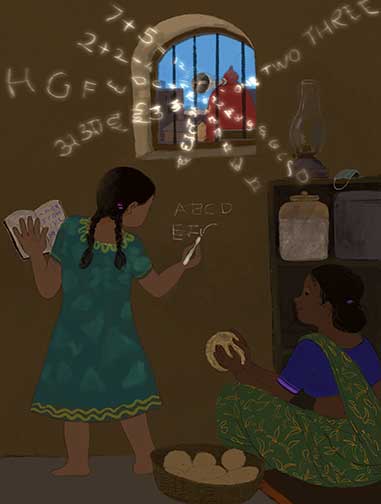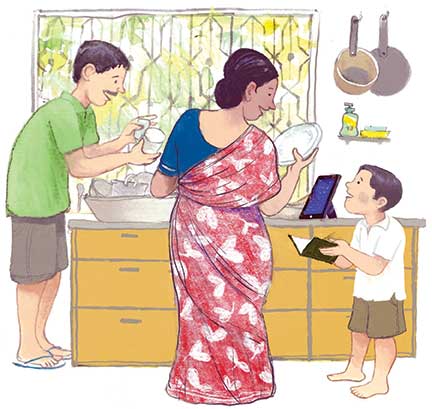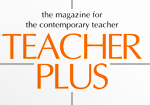Gopal Midha
Hum mandir ke upar loudspeaker baandh diye. Phir jo online program the, unko download kiye aur loudspeaker pe suna diye…. Baccho se link nahi tootne ka.
(We put a loudspeaker on the top of a temple. Then, whatever online programs were available, we downloaded them and played them on the loudspeaker….The link with the children should not break).
This comment was made by Rajaram (name changed) who is a Kendra Pramukh (cluster head) in a village in Maharashtra. I was struck by his improvisational skills in educational leadership during the pandemic. During an unprecedented crisis, he took the initiative, built on what was available and let-go of pre-COVID instructional delivery methods. Rajaram’s response is in contrast to many other institutional leaders who bemoaned the lack of smart phones with the students in their city/village and articulated a general sense of helplessness. Rajaram and his team’s actions reminded the children and their families that schooling can and will continue even when schools are closed. Their actions demonstrated a critical but overlooked skill in educational leadership, especially during a crisis1: improvisation.
Improvisation is a term often used in theatre or jazz circles as a form of play, but what is improvisation in education? Improvisation is a spontaneous, intuitive action that productively furthers an educational story. The act of improvisation is not pre-determined or a repeat of what worked earlier and has three guiding principles: yes-and, make-do and let-go (table 1). Also, improvisation can have levels (table 2)2. Educational leaders skilled in improvisation embrace ambiguity to take novel action that will improve teaching-learning and make their organizations more resilient to crisis.
Table 1 – A hypothetical case
| Leadership action | Imagine that a teacher breaks down during an online staff meeting citing the pressures of balancing teaching and cooking for the male members in her family. | |
| Yes-and | Show agreement and build | Acknowledge this inequity and build on how it gets enacted in other ways. |
| Make-do | Use what is available | Use this case and others’ stories to develop a lesson plan on equity within homes during the lockdown. |
| Let-go | Break the current narrative | View education as larger than subject knowledge, as about equity and social justice. |
I used the lens of improvisation to analyze interview responses from ten school and institutional leaders. I found four things. On the one hand, leaders improvised well during the pandemic by: (a) saying ‘yes-and’ to instructional technology that connects schools to their community and (b) making-do with parents by appointing them as para-teachers. On the other hand, leaders showed poor improvisational skills by: (c) refusing to let-go of the protocols that guided pre-COVID teaching-learning and (d) rarely acknowledging the amplified inequity. Overall, I found that school leaders’ actions comprised – the ‘interpret and embellish’ levels of improvisation (table 2). My interpretations may sound harsh or even confrontational and I am as disturbed by these as you perhaps are. Quite likely, I also simplified interpreting what leaders were kind enough to share. Yet, what I failed to hear was a fundamental and much-desired transformation of our teaching-learning and leadership.

Saying ‘Yes-and’ to instructional technology to maintain connection
Educational leaders showed that they cared deeply about maintaining connection with their students. Rajaram’s action of using the downloaded material from the Diksha app and then routing them through the loudspeaker to ensure ‘the link with the children’ finds resonance in accounts from other leaders. Says Indira, the principal of a private unaided school, “After every session, I made my teachers call the parents and find out why the students are not getting connected. Most leaders and teachers decided to sacrifice their summer holidays to improve their online instructional skills, especially to reconnect with their students. Says Chhaya, a private unaided school leader, “We didn’t get the May holidays; during that time we worked on how to get going online.” Karen, another private unaided school leader explains, “A lot of time was spent making teachers comfortable in using Zoom, getting them to use PowerPoint presentations, Word documents and so on”.
As connection with students became possible, the leaders initially relaxed teaching-learning quality norms. Says Mira, a private unaided school principal, “I told the parents, my teachers…just take it slowly.” This relaxation lasted only a few months though and by July 2020 the principals shifted gears towards stricter monitoring because of the poor quality of online instruction. Says Chhaya, “When I sat down and observed classes, I was not very happy. It was just a recorded lesson and we also got some negative feedback from parents.” The leaders shared that in 2021 they spent more time observing and monitoring instructional quality because compared to 2020, more students and teachers had access to devices, digital instruction became ‘normal’ and in-person teaching resumed at least in some schools. Says Mala, a block education officer, “We went from one cluster to another to inspect how teaching was being done following COVID safety norms.”
Making-do with parents as para-teachers and partners
In a strategy to help students focus on their homework, school leaders coaxed parents to become para-educators. Parents were now partners. Says Chhaya, “Parent-teacher meetings were happening and our focus was to make parents partners in learning.” Using chat engines like WhatsApp, leaders often created parent groups to communicate school time-tables and tasks that must be overseen at home and taught the parents how to use mobile apps. Rural school leaders like Rajaram and Abdul often went to their students’ homes, following safety norms, to encourage parents to prevent any breaks in their child’s schooling.
Such leadership improvisations were often made under pressure and ambiguity. Private unaided school leaders needed to ensure that parents continued to pay school fees or they would have to lay off teachers. Government school leaders also faced extreme pressure to report current enrolments and urged parents, often by making home visits following safety guidelines, to keep students enrolled.
‘No’ to letting-go of pre-COVID teaching and institutional norms
Although improvisation abounded in making teaching available online, school leaders found it difficult to ‘let-go’ of what they once believed was good education. The pandemic forced us to pause and gave us time to reflect and dialogue about issues such as rushing students through the school pipeline, summarizing student and school performance in neat statistical data, growing inequity and delivering standard curricula through grade-wise classes. But instead of using the lockdown time to pause, reflect and do less, leaders became more busy with restarting schooling. Says Maya, a private unaided school principal, “I was so engrossed with work that I don’t know how people complained about boredom.”
The interviews reflected that online instruction during COVID comprised subject and grade-wise teaching, 30-45 minute class periods, and the delivery model of instruction – which I would suggest are reminiscent of pre-COVID schooling and classroom protocols. For instance, an online instruction day was similar to what one may expect in the pre-COVID scenario. Says Asmita, a private unaided school principal, “So roughly, let’s say four hours a day or five hours a day the students would be online… for grades six to eight, it is three and a half hours but for grade 10 to 12, they start at eight and they are sitting till 2:10 with gaps between two periods.”Instructional videos were organized around one topic within one subject3. What I found disheartening was that more than half the school leaders also used terms such as lecture and delivery to refer to online classes. Says Uma, a private aided school principal, “My teacher plans for the 40 minute periods but she’s not able to deliver fully!” Abdul’s words emphasize this continuance of the pre-COVID delivery model of education, “We had to deliver education to the child…to continue the process.”
Table 2 – Leadership and teaching examples by levels of improvisation
| Pre-Covid practice | Interpret | Embellish | Vary | Improvise |
| Teaching: Instruction based on a lesson plan template. | Teach with similar parameters as earlier, but now delivery occurs online. | Add new elements to the lesson plan, e.g., use of chat boxes for formative assessment. | Online co-teaching combining tech savvy and non-tech savvy teachers; combining subjects to develop theme- based instruction. | Forming school networks wherein teachers from different schools form a community to exchange and showcase innovative pedagogical ideas. |
| Leadership: Observation and debrief with the teacher. | Observation and debrief are online. | Invite an online instructional expert during debrief. | Group debriefs, making audio recorded sessions available publicly for feedback. | Include parents actively in synchronous observation and debrief to further a dialogue about education. |
It would be unfair to blame the leaders because the pressure to resurrect conventional instructional protocols and methods came from parents, school boards and institutional diktats expecting business-as-usual. This desire to return to normalcy, as may be expected during a crisis, made it harder to pause to ask questions like: How can we draw upon what is happening right now to build thinking, emotional health and life skills? Why are we teaching fractions and grammar right now? How can we utilize the existing strengths of our tech-unsavvy teachers instead of forcing them to learn online skills? How can we use this time at home to ponder with parents and students over the growing inequity in our society? In the absence of such questions by school boards, education officers and school leaders, the conventional story of schooling drawled on.

Karen was the only school leader who attempted to change instructional norms by using the library as an improvisational space, a bridge of books to re-engage and invite students during the troubled pandemic waters. But she too felt that the pull of conventional schooling was strong. “You may start off on a good note and, get them to play a few games online, give them to do assessment slightly differently, but eventually everyone falls back.”
Amplified inequity below the radar
When I probed school principals for their key leadership challenges, I also wanted to understand how they felt and what they did about the widening inequity within and across schools. For instance, how they had improvised to support those students who needed one-on-one instruction or those who were beyond online access. I wanted to check if, as educational leaders, they could think beyond their schools, about the thousands of students and families who were left stranded. From their responses, I gathered that each school leader focused only on their school population and within that population, on those students and teachers who were accessible. To me, it seems that the public good of education was largely enacted as a private service. Technology, instead of breaking down walls, ended up building them higher.
Despite some of these shortcomings, I was moved by the passion and sincerity of the school leaders I spoke with. They worked long hours and took personal risks. For instance, when the government forced teachers and headmasters into COVID duty, two of the leaders I spoke with contracted the virus and ended up being quarantined. After recovery, they continued leading instruction to the best of their abilities.
In sum, improvisation is not only a toolkit to strengthen schooling, but a fundamental shift in perspective and that is why it is core to educational leadership. The pandemic, similar to an earthquake, razed the existing infrastructure. This was an opportunity to reconsider and reimagine schooling. The levelling could have led to partnerships across schools, a honeycomb of interconnected public and private building wings. Instead, the new infrastructure mirrored pre-COVID silos of school buildings with technologically advanced and jazzy instructional wiring. Improvisation cannot happen when we stubbornly conceive schools as individual silos, organizations that must uphold learning but have little to teach and learn from each other or within whose walls education is narrowly conceptualized only in terms of exams, grades and subject knowledge.
To conclude, as schools again go back and forth with re-opening, we still have a window of opportunity. But for that, we need policy makers, scholars and leaders taking joint responsibility of taking spontaneous, productive action that furthers our children’s future. This will be uncomfortable, but staying with discomfort is one thing that the pandemic has taught all of us, has it not?
- Schools, suggests research, are an important disaster-recovery institution. For example, just after a cataclysmic crisis like an earthquake – one of the first things that governments must attend to after ensuring health and safety is re-start schooling. Children heading to school benefit from healthy socialization and to others, they deliver a perceived sense that things are returning to normal. https://link.springer.com/content/pdf/10.1007/s11069-016-2204-5.pdf
- I provide a more detailed understanding of improvisation in my paper in the ISEA journal. Please write to me if you need a copy.
The author is currently planning to set up a Center for research in educational leadership in Goa. He also facilitates improve theatre workshops to strengthen leaders in educational institutions. He can be reached at gopalmidha@gmail.com.
Related Articles
